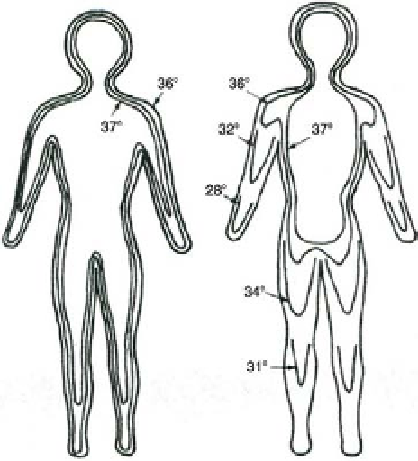Biomedical Engineering Reference
In-Depth Information
FIGURE 14.44
Temperature distribution in the human body, with the left figure depicting the temperature
distribution in a warm environment and the right figure for a cold environment.
From Ruch and Patton (1965).
Although the temperature nearest the skin is lower in a cold environment, the use of
clothing with trapped air prevents the skin temperature from becoming dangerously cold.
For someone in an extremely cold environment, such as outer space, the use of an
encapsulated suit is needed because the exterior temperature is extremely low. In an earth-
bound environment, the issues associated with insulating clothing do not address the
added issue of heat loss (or gain) via respiration. We will soon see how respiration can
be an important element in heat loss from the body.
14.3.3 Thermal Convection
Convection is heat transfer via bulk motion of a fluid, which can be a liquid or a gas.
Examples of convective heat transfer include air conditioning coming from a compressor,
blower, and ductwork; windchill; heat exchangers; and blood warming/cooling as part of
heart/lung machines (also called cardiopulmonary bypass).
Convective heat loss can be forced or via natural (unforced) mechanisms. Forced convec-
tion is commonly due to a pressure gradient or other forcing function that would move a
fluid (with its associated heat) to another position or location. Thus, a forced air system con-
sisting of an air conditioner, blower, and vents is an example of a forced convection system.
Another is windchill, which results from a pressure gradient moving air across a surface
and removing heat from that surface. If an individual experiences windchill, he or she
would feel colder because the windchill would remove heat from the skin.
Natural or unforced convection is due to thermal gradients in a fluid that result in fluid
motion due to buoyancy differences. Thus, hot air rises because it is lighter than cold air.


